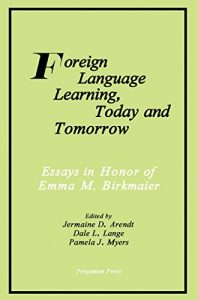Foreign Language Learning, Today and Tomorrow is a collection of papers that attempts to shed lights into the concerns and issues that will be encountered by foreign language instructors.
The title first deals with the futurism in foreign language learning, and then proceeds to humanism in learning foreign languages. Next, the selection presents a thematic approach in learning a second language. The text then covers the individualization of foreign language learning. Chapter 5 cites some studies, which claim that children can learn to read far earlier. The selection also covers the system for evaluation of a foreign language program, along with the sequence of learning activities that work well in the classroom. Chapter 8 talks about possibility of language learning thrive as an elective in American schools, while Chapter 9 deals with individualizing and sequencing training for inter-cultural communication. The last two chapters detail the alternatives in education and suggestions for the continuing development of pre- and in-service programs for teachers of second languages.
The book will be of great use to foreign language instructors. Individuals who are involved in the design and implementation of school curriculum will also benefit from the text.
The title first deals with the futurism in foreign language learning, and then proceeds to humanism in learning foreign languages. Next, the selection presents a thematic approach in learning a second language. The text then covers the individualization of foreign language learning. Chapter 5 cites some studies, which claim that children can learn to read far earlier. The selection also covers the system for evaluation of a foreign language program, along with the sequence of learning activities that work well in the classroom. Chapter 8 talks about possibility of language learning thrive as an elective in American schools, while Chapter 9 deals with individualizing and sequencing training for inter-cultural communication. The last two chapters detail the alternatives in education and suggestions for the continuing development of pre- and in-service programs for teachers of second languages.
The book will be of great use to foreign language instructors. Individuals who are involved in the design and implementation of school curriculum will also benefit from the text.



